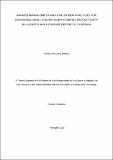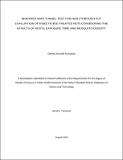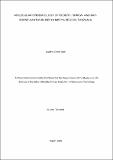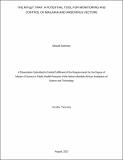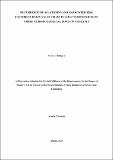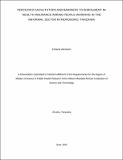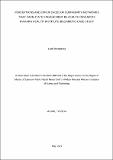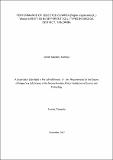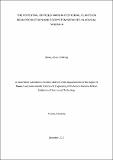Browsing Masters Theses and Dissertations [LiSBE] by Title
Now showing items 97-116 of 134
-
Larvicidal and phytochemical analysis of Hypoestes forskaolii extracts against Anopheles gambiae, Aedes aegypti and Culex quinquefasciatus
(NM-AIST, 2020-08)This research evaluated larvicidal potencies and phytochemical analysis of Hypoestes forskaolii (vahl) R. Br root extracts. Larvicidal activities were tested to Anopheles gambiae, Aedes aegypti and Culex quinquefasciatus. ... -
Maize store‒time marketing model for northern zone of Tanzania
(NM-AIST, 2019-04)This study was carried out to create a marketing model that integrate maize store-time with five storage methods namely Perdue Improved Cowpeas Storage bags (PICS), Metal Drums, Kihenge, Polyethylene bags with insecticides ... -
Managing aflatoxin – producing fungi using indigenous atoxigenic strains of aspergillus species in groundnut in Mtwara region, Tanzania
(2019-04)The present study was conducted from January to October 2018 in Mnanje, Mpeta and Naliendele villages to determine aflatoxin levels in dried groundnut kernels, to identify toxigenic and atoxigenic strains of Aspergillus ... -
Manure management and utilization practices for enhancing smallholder dairy farming productivity in Lushoto and Korogwe districts, Tanzania
(NM-AIST, 2019-02)The use of cattle manure in agricultural fields improves soil quality and contributes to nutrient recycling when applied back to the soil compared with synthetic fertilizers that are associated with high cost and limited ... -
Mixed method study to evaluate factors associated with discarding of long-lasting insecticidal nets in Bagamoyo, Tanzania
(NM-AIST, 2022-08)Between 2000 and 2019, more than 1.8 billion long-lasting insecticidal nets (LLINs)were distributed in Africa. While the insecticidal durability of LLINs is around 3 years, nets are generally discarded 2 years ... -
Modified who tunnel test for high through put evaluation of insecticide-treated nets considering the effects of hosts, exposure time and mosquito density
(NM-AIST, 2022-08)The standard World Health Organization (WHO) tunnel test is a reliable laboratory bioassay used for "free flying" testing of Insecticide Treated Net (ITN) bio-efficacy. Multiple parameters affect the outcomes measured ... -
Molecular epidemiology of rodent-, shrew- and bat-borne hantaviruses in Mbeya region, Tanzania
(NM-AIST, 2019-03)Hantaviruses, family Bunyaviridae are emerging zoonotic RNA viruses, which originates from rodents, bats and shrews. Expanded diversity of Hantaviruses with their respective reservoir host in Africa stimulates the research ... -
Morphological and physiological responses of the invasive plant gutenbergia cordifolia to varying biophysical conditions
(NM-AIST, 2022-07)This study assessed the effects of varying water stress levels on morphological and physiological traits of an invasive plant Gutenbergia cordifolia (G. cordifolia) under field and screen house conditions and the ... -
Morphological screening and farmers’ acceptability of selected lablab bean (lablab purpureus) accessions in Moshi district, Tanzania
(NM-AIST, 2019-04)A set of 41 lablab bean accessions were evaluated based on morphological characteristics and farmers’ participatory selection was performed based on agronomic and sensory traits. An experimental plot was laid down in ... -
The mtego® trap: a potential tool for monitoring and control of malaria and arbovirus vectors
(NM-AIST, 2023-08)Odour-baited traps are valuable for vector surveillance and control; however, they often exhibit varying recapture rates among mosquito species due to the limited range of host cues they provide. Therefore, it is crucial ... -
The mtego® trap: a potential tool for monitoring and control of malaria and arbovirus vectors
(NM-AIST, 2023-08)Odour-baited traps are valuable for vector surveillance and control; however, they often exhibit varying recapture rates among mosquito species due to the limited range of host cues they provide. Therefore, it is crucial ... -
Occurrence of aflatoxins and associated risk factors in dairy value chain in selected districts of three agro-ecological zones in Tanzania
(NM-AIST, 2023-08)Aflatoxins are natural compounds produced by specific type of fungi, which contaminate foods and animal feeds. This study assessed the occurrence of aflatoxins and associated risk factors in livestock feeds and raw cow ... -
Perceived facilitators and barriers to enrolment in health insurance among people working in the informal sector in Morogoro, Tanzania
(NM-AIST, 2022-06)Health financing is an important pathway towards universal health coverage (UHC). In Tanzania, despite an improved Community Health Fund (iCHF) rollout, people in the informal sector haven’t been fully enrolled. This ... -
Perceptions and experiences of community-networks that facilitate engagement in health research: Ifakara Health Institute-Bagamoyo case-study
(NM-AIST, 2021-05)Involvement of communities in the field of health research collectively known as community engagement is considered as ethical conduct of research. At the Ifakara Health Research Institute (IHI) in Bagamoyo, Tanzania, ... -
Performance of selected cowpea (vigna unguiculata (l.) walp) varieties in different soil types in Singida District, Tanzania
(NM-AIST, 2017-12)A participatory research was conducted in Singida District central Tanzania under Singida Nutrition and Agro ecological Project (SNAP), during the 2016/2017 cropping season to evaluate the performance of cowpea (Vigna ... -
Persistence and diversity of Theileria parva in East Coast fever vaccinated and unvaccinated cattle
(NM-AIST, 2019-11)Infection and Treatment Method (ITM) has been practiced in Tanzania for over 20 years now as a prevention method against East Coast Fever (ECF). However, there is less information regarding the persistence of the Theileria ... -
Phenotypic and biochemical screening of sorghum genotypes for growth and rice weevil resistance in Tanzania
(NM-AIST, 2019-04)The current study characterised sorghum genotypes based on their growth morphological variations; identified phenotypic and biochemical traits, and screened them for resistance to rice weevil (Sitophilus oryzae). A total ... -
The potential of field margin pesticidal plants on bean production and ecosystem services in Arusha, Tanzania
(NM-AIST, 2017-12)An experiment was undertaken in NM-AIST farms in Arusha Tanzania from January to July 2017 to assess the potential of pesticidal plants on supporting the beneficial insects, controlling pests’ and influencing bean growth ... -
Predation efficacy of anopheles funfests larvae by Aquatic predators in rural South Eastern –Tanzania
(NM-AIST, 2023-08)The study aimed to examine the impact of 3 common predator on Anopheles funestus larvae. Specifically, (a) The impact of predator on larval and adult density (b) The impact of aquatic predation on fitness traits of ... -
Preferred resting surfaces of dominant malaria vectors inside different house types in rural south-eastern Tanzania
(NM-AIST, 2020-02)Malaria control in Africa relies extensively on indoor residual spraying (IRS) and insecticidetreated nets (ITNs). Indoor residual spraying typically targets mosquitoes resting on walls, and in few cases ...




